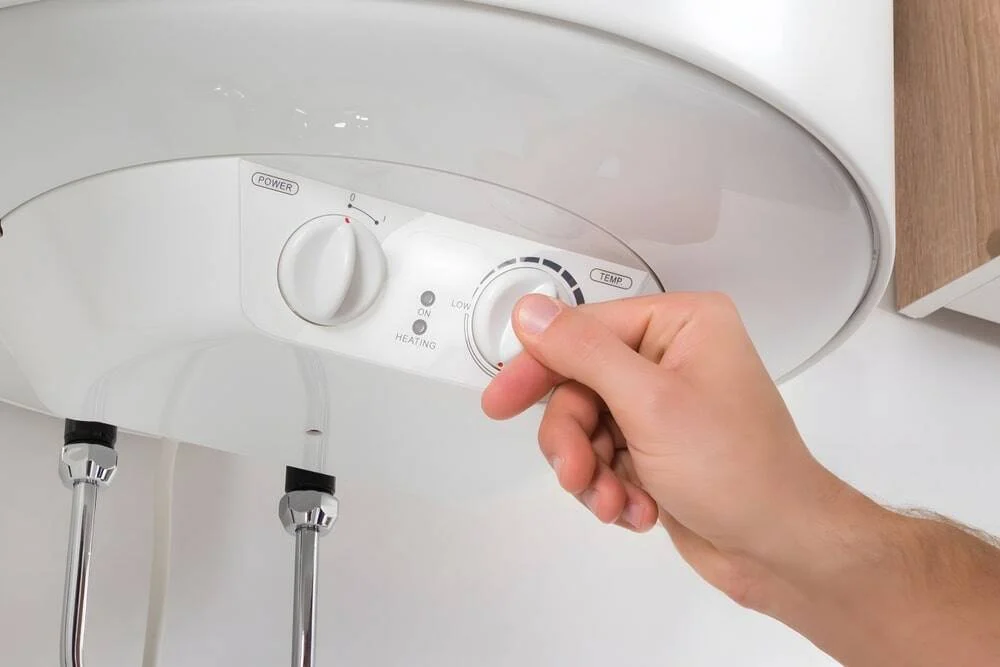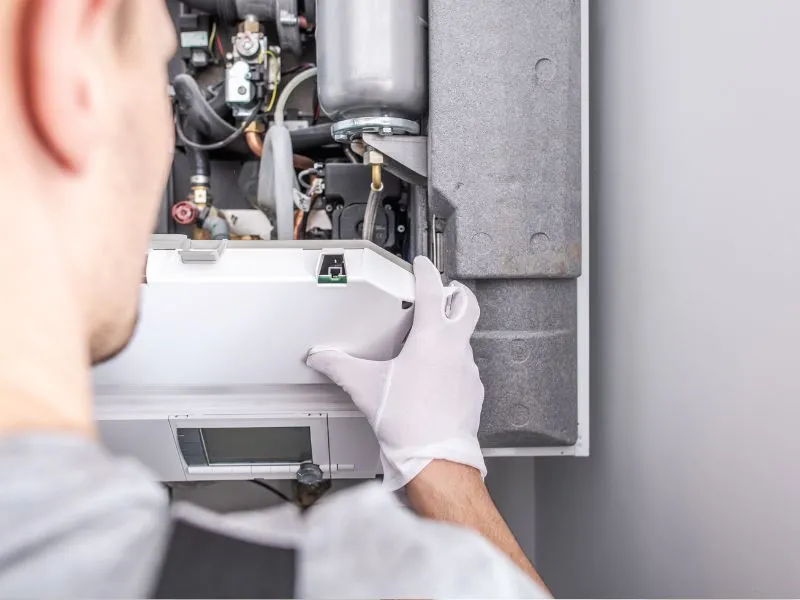When your boiler stops heating water, it throws daily life into chaos. No hot showers, no warm sinks, just frustration. The good news is most issues have straightforward fixes.
From pressure drops to faulty parts, knowing the basics helps you spot the problem faster and decide whether it’s a DIY fix or a call to a pro.
Why is my boiler not heating water?
A boiler may stop heating water due to low pressure, faulty parts, airlocks, or frozen pipes. Check basics first, then call a pro if issues persist.
Key Takeaways
- Boilers stop heating water due to issues like low pressure, thermostat faults, airlocks, or faulty parts.
- Quick DIY checks include pressure gauge, thermostat reset, radiator bleed, or clearing frozen pipes.
- Persistent problems (valves, pumps, wiring, gas) require a professional.
- Annual servicing, radiator bleeding, and system flushes prevent breakdowns.
How Boilers Heat Water: The Basics

A boiler’s job is pretty simple: heat water and push it where you need it. It burns gas or oil, or uses electricity, to warm up water inside a sealed chamber.
That hot water or steam then gets pumped through pipes to taps, showers, or radiators. If the boiler’s working right, you get steady heat and hot water on demand.
Think of it as your home’s backstage crew, quietly running the show. When that system slips up, you’re left with lukewarm showers and cold radiators—exactly the kind of problem that calls for expert boiler repair in North Smithfield.
Common Causes of a Boiler Not Heating Water
1. Thermostat Issues
Sometimes it’s not your boiler, it’s the thermostat calling the wrong shots. If the settings are too low or the device is faulty, your system won’t kick in. Double-check the temperature setting, swap batteries if it’s wireless, and reset it before panicking.
2. Low Water Pressure
Boilers hate running on empty. If the pressure gauge is sitting below one bar, your system doesn’t have the juice to push hot water around. The quick fix? Top it up with the filling loop until the needle lands in the safe zone.
3. Airlocks in the System
Air pockets are like traffic jams in your pipes. They block hot water from moving through, leaving your taps cold. Bleeding your radiators usually clears them out, but stubborn airlocks might need a pro with specialist tools.
4. Frozen Condensate Pipe
Cold snaps turn your condensate pipe into an ice block, and when it’s frozen, your boiler shuts itself down. A safe DIY move is pouring warm water over the pipe to melt the ice. If it keeps happening, insulation is the long-term flex.
5. Pilot Light or Ignition Problems
No flame, no heat. Older boilers use a pilot light, and if it keeps blowing out, the thermocouple could be faulty. Newer ones rely on electronic ignition, which sometimes just needs a reset or a spark module swap.
6. Faulty Diverter Valve
Think of the diverter valve as the traffic cop of your boiler, sending hot water either to your radiators or your taps. If it’s stuck, you’ll get heating but no hot water, or the reverse. It usually needs a pro replacement, so don’t wrestle with this one yourself.
7. Limescale Build-Up
If you live in a hard water area, scale is your silent enemy. Over time it clogs pipes and coats the heat exchanger, stopping water from heating properly. A system flush or a limescale filter can keep things flowing smoothly.
8. Broken Pump
The pump is what moves hot water around your home. If it’s faulty or seized, you’ll notice cold radiators and dead taps even when the boiler is on. Sometimes a gentle reset works, but often it needs repairing or swapping out.
9. Tripped Safety Switches
Boilers come with safety features that trip when they detect something sketchy. Overheating, leaks, or blocked vents can all trigger a lockout. Resetting is fine once, but if it happens again, call a professional—don’t just keep hitting the button like a broken lift.
10. Electrical Faults
If your boiler’s lights are out, it might be sulking from an electrical issue. A blown fuse, dodgy wiring, or power cut could all be the culprit. Check your mains supply and fuse box before assuming the boiler itself is toast.
11. Pressure Relief Valve Problems
This valve is there to keep your system safe, but if it’s faulty, water pressure can crash. You’ll spot drips or leaks around the pipe outside. Unfortunately, this one’s a pro fix—don’t mess with the safety gear.
12. Blocked Pipes or Sludge Build-Up
Years of rust and debris create thick sludge that clogs your boiler’s arteries. The result? Lukewarm water, noisy pipes, and random cold patches. A power flush clears the gunk, and adding inhibitor fluid keeps it from making a comeback.
13. Gas Supply Issues
No gas, no heat. If other gas appliances aren’t working either, it’s probably your supply. Call your provider to check, but if it’s just the boiler, you’ll need an engineer to check valves and connections.
14. Incorrect Boiler Pressure Setting
Even if you’ve topped it up, the system can misbehave if the pressure isn’t balanced. Too high, and the safety valves trip. Too low, and you won’t get flow. Most boilers are happy around 1–1.5 bar, so keep it in that sweet spot.
15. Old or Failing Boiler
Sometimes the hard truth is your boiler’s just past its prime. Older models wear down, parts become scarce, and repairs start costing more than they’re worth. If you find yourself constantly needing boiler repair in Johnston, it might be time to consider upgrading to a newer, energy-efficient model.
When DIY Stops Working: Calling a Professional

Sometimes, no matter how many YouTube hacks you try, the boiler just won’t cooperate. If you’ve already checked basics like the thermostat, pilot light, and pressure gauge, and it’s still not heating, it’s time to step back.
Boilers deal with gas, water, and electricity, which is not a cocktail you want to mess with. A pro has the tools and training to diagnose deeper issues like faulty valves, broken pumps, or wiring problems without turning your basement into a hazard zone.
Think of it this way: you wouldn’t cut your own hair with kitchen scissors before a wedding, right? Same energy.
Call a certified technician, save yourself the stress, and get the hot water flowing again safely. If you’re wondering how much time to replace a boiler, the answer is usually quicker than tackling it on your own—sometimes the smartest DIY move is knowing when to pass the wrench.
Preventive Maintenance Tips
Think of your boiler like your car, it needs regular check-ups to stay smooth. Get it serviced yearly so small issues don’t turn into wallet-draining repairs.
Bleed your radiators to keep heat flowing evenly, and keep an eye on pressure levels so they don’t drop too low. Clear any blockages around vents or flues, because airflow is the cheat code for efficiency.
And don’t ignore weird noises. A rattle now could be tomorrow’s cold shower. A little routine care keeps your boiler reliable, efficient, and ready to flex when winter hits.
Frequently Asked Questions
1. Why isn’t my boiler heating water but the heating works?
Your diverter valve may be stuck. It sends heat either to your taps or your radiators. If it’s jammed, call an engineer.
2. Why do I only get lukewarm water?
That’s usually low water pressure or a faulty thermostat. Quick fix: check the pressure gauge. If it’s under 1 bar, top it up.
3. Why does my boiler keep switching off?
Blocked pipes or trapped air can trigger this. Try bleeding your radiators. If it keeps happening, you’ll need a pro.
Conclusion
A boiler that’s not heating water can feel like a nightmare, but most fixes are simple. Sometimes it’s just pressure, airlocks, or a pilot light playing up. Other times, it’s a part that’s checked out and needs swapping.
If you’ve run through the quick checks and it’s still cold showers, call in a pro before things snowball. Staying on top of small issues now saves you from big repair bills later.
Think of it as keeping your boiler in the same league as your Wi-Fi—quiet, reliable, and always on.